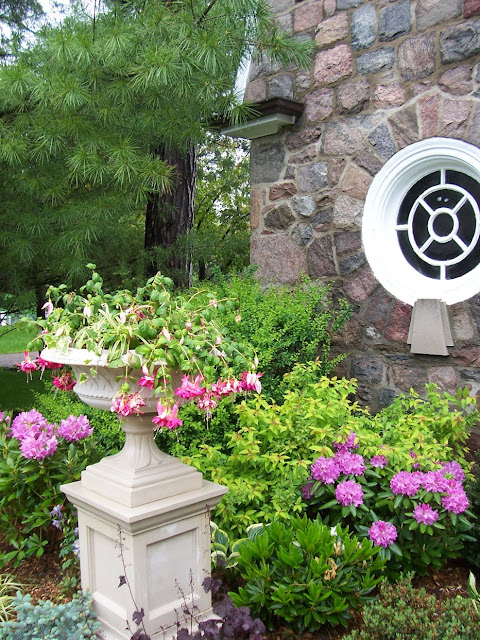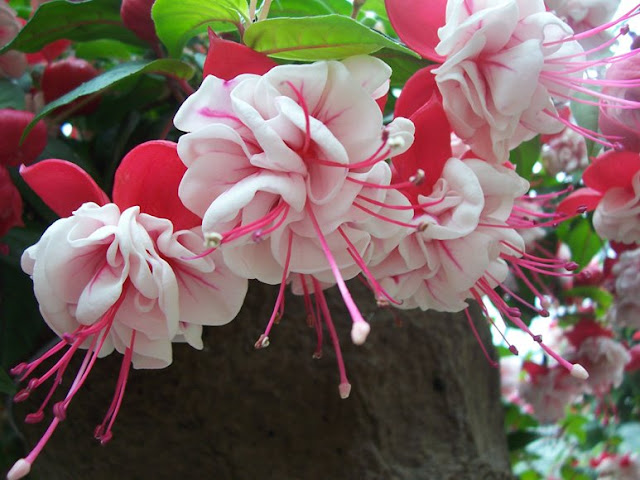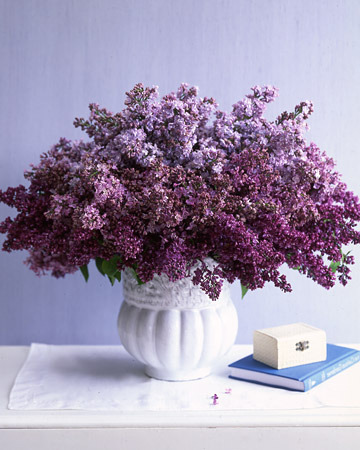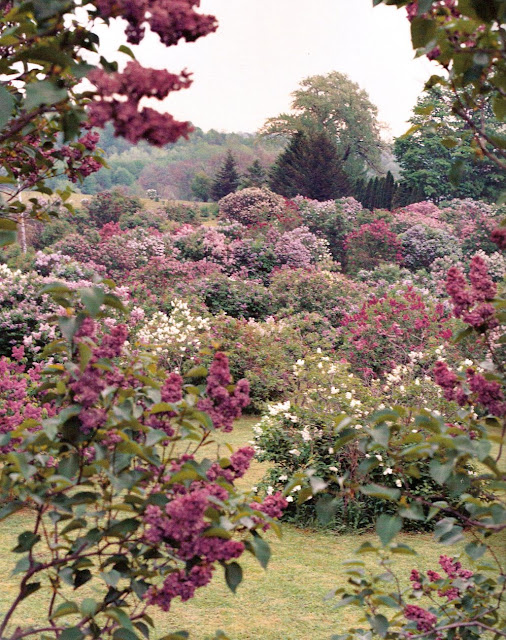I love a good house tour - public or private. So, today, on my day off, I went with my beloved to see the McLean House on the grounds at Sunnybrook. The house has been newly decorated by 70 of Toronto's leading interior designers brought on board by the Junior League of Toronto to help benefit the Sunnybrook Hospital.
The rooms were spectacular! Sadly, photography was strictly forbidden. At every turn, down every corridor, was a pleasant looking woman wearing a light-blue apron who had been instructed to severely punish anyone who dared to take a photograph of any of the rooms. My plan to take dozens of pictures and post them here was thwarted. Below, however, you'll see some photographs of the grounds.
My favourite room was the main study on the ground floor, designed by Brian Gluckstein of Gluckstein Design Planning Inc. Dark wood panelling, a stunning bay window with a view to the gardens, sleek, modern furniture and extraordinary lighting gave the room the perfect blend of traditional and modern. The main feature was an enormous Japanese screen made of ebony that stretched across one of the walls, giving the room added depth. A roaring fireplace was kept minimally adorned.

"We wanted to create an environment that reflects the trends from 1929 when the residence was constructed and today, in 2009. The study's pine panelling, which reflects a mixture of classical architecture, was a popular material in these houses and remains a key design element in the house today," says Gluckstein.
The update was achieved through the furnishings, which were long, sleek and sturdy, many of them reminescent of the Art Deco period but updated with a modern pallette of greys, lavenders and creams.
Another favourite of ours was a room concept in the basement called "The Apartment of Lady X" by Wiklem Design. The room was certainly as naughty as the title suggests. Made to look like the classy suite of an empowered mistress, the room just exuded dark sensuality. And the room was dark: brick walls painted a clean black, a large, round, black marble table, a black desk outfitted in black leather, black lamps and ebony dressers. Lightness was brought into the room through mirrors and a recessed counter made of glass, lit from behind by clean white fluorescents. A sunken lounge area was arranged with sexy chaises and a vignette of white sculptures. The photography in the tight space was black and white and glamorous, featuring glorious portraits of Tina Turner, Mick Jagger and Jackie Onassis. The feeling is one of strength and sensuality - totally compelling!
Tomas and I were the only men in the place, which seemed to make us popular with the ladies. Many of them asked us our opinions about the rooms, what we liked, what we didn't. There were moments that we felt like the guides. It was a great way to spend a rainy afternoon. The house is open for tour until Saturday. For information visit jltshowhouse.com.
 All visitors are given this beautiful catalog, which has a designer's sketch of each room and biographies of the designers.
All visitors are given this beautiful catalog, which has a designer's sketch of each room and biographies of the designers.
History of the McLean House:
The McLean house dates back to 1928 when James Stanley McLean, President and Founder of Canada Packers, commissioned architects George Moorhouse and and King Associates to design a country retreat for his family on 50 rolling acres in Toronto, which he purchased for just over $90,000. The result was a house called Bay View (known today as McLean House, which is located on Bayview Avenue) one of Ontario's most splendid mansions. The fieldstone manor was embellished with Palladian windows, classic crown moldings, a grand circular staircase 12-foot ceilings and spaciouis rooms for grand entertaining. The acres of gardens were professionally landscaped by Gordon Culham, a landscape architect who worked in the tradition of formal English country style, with courtyards, manicured hedges and numerous urns filled to brimming with all manner of foliage and flowers.
The home remained the residence of the McLean family until 1966 when the widow of J.S. McLean moved to a smaller residence. The University of Toronto took over the property and it was converted into a clinical facility by Sunnybrook Hospital soon thereafter. In 1982 the house was renovated by the Junior League of Toronto and the Interior Designers of Ontario, who opened it to the public as a designers' showcase home. Following its transformation, the estate was opened as a venue for social and corporate events, with proceeds going to fund medical research for the hospital.
Photos of the Grounds:
 A view of the stately McLean house from the courtyard at the back of the residence.
A view of the stately McLean house from the courtyard at the back of the residence.
 Note some of the intricate architectural details around the windows on the second floor.
Note some of the intricate architectural details around the windows on the second floor.
 At every turn outside the home was an urn of some sort, piled high with flowers.
At every turn outside the home was an urn of some sort, piled high with flowers.
 The back terrace was an inviting space.
The back terrace was an inviting space.
 On the same terrace were several concrete urns. This one is home to an enormous staghorn fern.
On the same terrace were several concrete urns. This one is home to an enormous staghorn fern.
 We were both taken by the gnarled trunk of this mysterious tree.
We were both taken by the gnarled trunk of this mysterious tree.
 A conservative formality rules the many gardens on the property: restricted palettes of white and green.
A conservative formality rules the many gardens on the property: restricted palettes of white and green.
 The entrance to the coach house was a lovely space to consider.
The entrance to the coach house was a lovely space to consider.


















 All visitors are given this beautiful catalog, which has a designer's sketch of each room and biographies of the designers.
All visitors are given this beautiful catalog, which has a designer's sketch of each room and biographies of the designers.

































